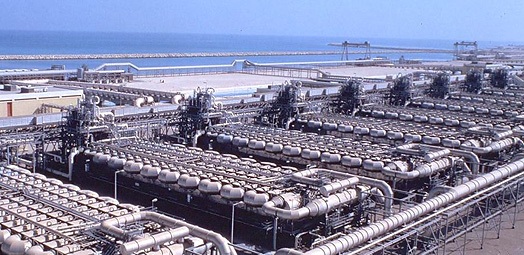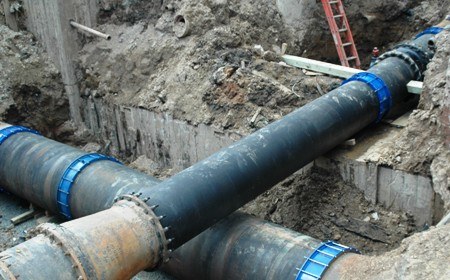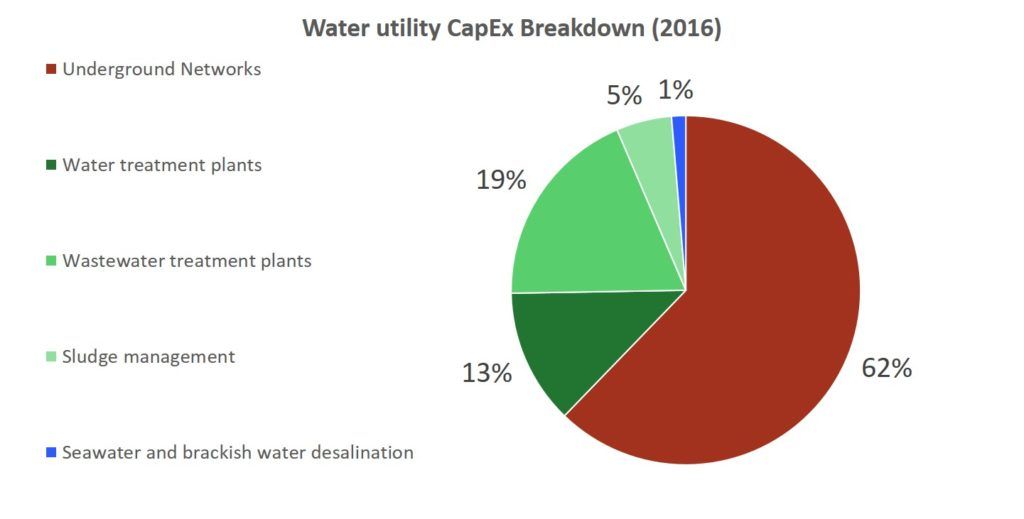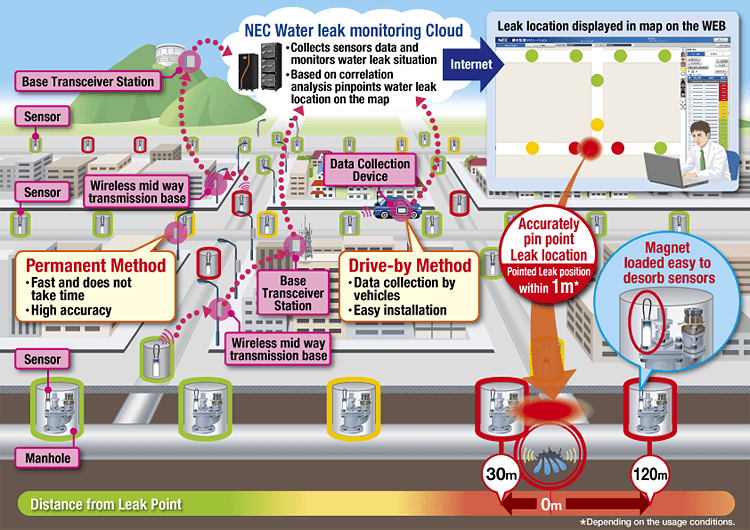Water Innovation – Shedding Light on Big Underground Market

NEC, Japanese IT Company, tries to enter water market through digitization strategy, a move which could potentially innovate water network through power of IT network
Water Business
800 billion USD – this is the market size of water infrastructure-related business globally [1]. I believe water business has both scale and social impact. In this traditional, relatively conservative industry, digital transformation has potential to offer a solution to one of the most important issues in the industry – aged water networks.
When I heard of “water business” for the first time, I imaged a fancy water treatment plant, such as a huge-scale desalination plant.
 [2: Al Jubail, Phase II in Saudi Arabia]
[2: Al Jubail, Phase II in Saudi Arabia]
However, surprisingly, water network, which is invisible in most cases because they are buried underground, shares more than half of total water CapEx market (i.e. many a little makes a mickle…). Water network looks less fancy, but is arguably as important as water treatment plant.
Underground Water Network Market
So, what is water network market like?
Intuitively, I thought at first water network market would be about emerging economies where water infrastructure has not been sufficiently installed. However, statistics shows counter-intuitive fact: although emerging economies share a certain share in this market, the majority of business is in developed economies (note: China’s water coverage rate (83.9%) is as high as other developed economies [5]).
In fact, water network in developed economies is facing ageing infrastructure under severe constraints on capital at municipality level. Much of the existing pipe network across Europe and North America was laid in the early 1900s in response to population and urbanization at that time.
After 100 years, it is estimated that US needs to invest for water network refurbishment about $247.5 billion (!) (of total $384.2 billion in overall water infrastructure) between 2011 and 2030 [7].
Tragedy from Ageing Water Network
Ageing water network reminds me a couple of incidents which happened in the US during a past few years: water main burst in Los Angels (where 93-year old water main burst), as well as Flint contamination (although there are multi-faceted aspects in this incident, one of the important technical aspects was ageing water network which is vulnerable for lower-quality raw water). Those two incidents tell us how important it would be to take care of ageing infrastructure in the US (and in other developed economies), too.
Maintenance & Rehabilitation of Water Network
Traditionally, water network maintenance has been done manually (see a photo below for typical detection work). Employees looked for water leakage using detection equipment without much clue about where the leakage is, often only after a major water disturbance occurred. However well-trained technicians could be, locating leakage point is tough (imagine yourself trying to find an inch-sized leakage point in Spangler Lawn).
NEC, Japanese IT Company, Goes to Water Market
NEC found this inefficiency could be solved by introducing a combination of sensor, wireless base station, and cloud system which is equipped with a unique leakage analysis engine and a leakage-fixing service application.
1) Leakage analysis engine: Conduct correlation analysis among multiple nearby sensors to locate the leakage point with precision with +- 1m error.
2) Leakage-fixing service application: Based on the information from leakage analysis engine, provide leakage detection technicians with locations of sensors on Google Maps with leakage points colored based on their “leakage score” (probability of leakage occurrence). This app also supports technicians by providing historical maintenance record for each point, and helps to write their daily report. [11]
In addition to leakage maintenance, NEC is working on further development of this cloud system to accurately estimate water pipes’ condition based on the information from sensors, geological conditions, material specification of pipes, and the number of years since their installment. [12] This estimation will be extremely valuable for water utility companies to prioritize its capital expenditure programs.
US Market – Largest Potential
Aware of US’s huge market potential, NEC started its sales activity in 2015. The first client has been the City of Arlington, Texas. NEC installed a series of 33 sensors at 2 main sites in Arlington water system, finding and fixing 3 leakages during 4-month trial. [14]
My Recommendations
So, where can NEC go from here? It seems to me that technologies and ideas are working; so, the question is how to build a viable business model. In this regard, my recommendations are as follows:
1) Revenue sharing business model – NEC should propose a fee structure with initial payment to (partly) recoup its sensor cost, and a profit-sharing model based on pre-agreed metrics.
2) Partnership – Tie-up with local water engineering companies which have strong relationship with utility companies.
3) Local involvement – Standardize sensor manufacturing procedure so that local manufactures could also play a role of supply chain. In my previous experiences, water network industry is highly localized; many utility companies prefer to use local companies for political reasons. Since preventing leakage could potentially lose local contractors’ job to fix it, NEC should consider providing opportunity for local contractors to enjoy some benefits.
(Word Count: 799)
Reference:
[1] “Global Water Market 2017” by Global Water Intelligence
[2] Photo cited from http://www.sasakura.co.jp/e/products/water/106.html (Accessed in Nov. 2016)
[3] Photo cited from http://www.phillywatersheds.org/category/blog-tags/news-stream?page=4 (Accessed in Nov. 2016)
[4] “Global Water Market 2017” by Global Water Intelligence
[5] “Global Water Market 2017” by Global Water Intelligence
[6] “Global Water Market 2017” by Global Water Intelligence
[7] “Global Water Market 2017” by Global Water Intelligence
[8] http://www.nbclosangeles.com/news/local/Water-Main-Break-Raises-Questions-About-Citys-Aging-Pipes-269410741.html (Accessed in Nov. 2016)
[9] http://www.hbs.edu/news/articles/Pages/macomber-flint-michigan.aspx (Accessed in Nov. 2016)
[10] Photo cited from http://webtown.nagayo.jp/suido/okyaku/main14.html (Accessed in Nov. 2016)
[11] NEC Technical Report Vol. 67, No.1
[12] NEC Technical Report Vol. 67, No.1
[13] http://www.nec.com/en/global/solutions/waterloss-management/images/ (Accessed in Nov. 2016)
[14] http://www.arlington-tx.gov/news/2015/07/16/arlington-and-nec-partner-to-conduct-water-leak-detection-trial/ (Accessed in Nov. 2016)



 [3]
[3] 



Interesting post highlighting something we often take for granted: easy access to fresh water! Water networks are often underappreciated since these networks are rarely visible to the human eye; so, the figure that ~$250 billion will need to be invested in these networks by 2030 is staggering.
After learning more about NEC, it seems like they do not manufacture the sensors in-house and instead purchase them from a Swiss manufacturer, Gutermann. Therefore, NEC’s differentiation stems from their cloud-based software and application for collecting and storing the data. Do you think NEC will be able to differentiate solely through their software, or will they need to vertically integrate the production of the sensors? On the other hand, what stops a manufacturer, like Gutermann, from producing software in-house to compliment their product?
Also, does NEC provide the labor to go into the field to find the leaks or do they simply provide the data to the customer who then must send their own labor to detect the leaks?
It seems like NEC has a very asset-light operating model since they are providing the software overlay on Gutermann’s products. Very interesting example of how IoT is transforming operating models for companies!
Reference – http://www.nec.com/en/global/solutions/waterloss-management/
Satoshi! Arlington Texas is right where I grew up. They also just invested tons of money in infrastructure in the area as the Dallas Cowboys gigantic new stadium was just built there a few years ago. I couldn’t find anywhere that specified the cost of the new system. The city of Arlington’s website was conspicuously silent(http://www.arlington-tx.gov/news/2015/07/16/arlington-and-nec-partner-to-conduct-water-leak-detection-trial/). Do you have any idea what the cost might be? I am curious if the system is affordable enough that areas which do not have water conservation issues would be interested. It is routine in Texas that you are not allowed to water your yard or run a hose during daylight hours due to water conservation efforts. This is a huge inconvenience for the residents of these areas and many yards end up brown and dead.
Also, the link Emily posted(http://www.nec.com/en/global/solutions/waterloss-management/) implies that it is a fairly non-intrusive process to install the sensors if there is a manhole. Do you have any notion of how much of existing water infrastructure is readily accessible in such a manner?
Very interesting, Satoshi!
Here is a piece of data to show how important this matter is: about 40% of Brazilian water is wasted (because of leakage) before anyone uses it! This sort of technology could have a huge impact, especially in areas struck by droughts. (The USA wates about 13%), acoording to the sources:
http://g1.globo.com/economia/crise-da-agua/noticia/2015/03/brasil-fica-na-20-posicao-em-ranking-internacional-de-perda-de-agua.html
https://database.ib-net.org
I would be interested to know if they plan to go to the “smaller markets” as well. I can see great potential impact by doing business in developing countries as well (even though you have noted that the market is smaller).
Very cool post! I am wondering whether the same technology could be used for other applications as well. In particular, I am thinking of the tremendous issues Nigeria has with its oil pipelines, both because of faulty infrastructure and theft from the pipelines themselves. Are there applications in that vein that this could be used for? I echo others’ concerns around cost, but given how expensive it is to find and fix issues currently, it would be interesting to see the NPV of this kind of investment over time!